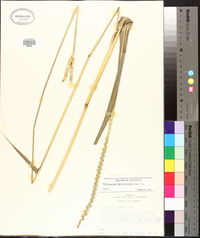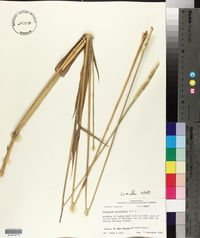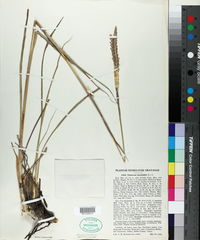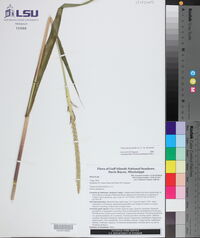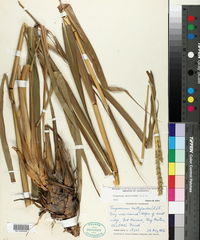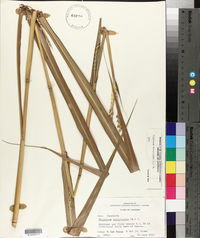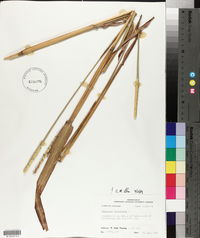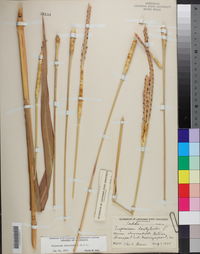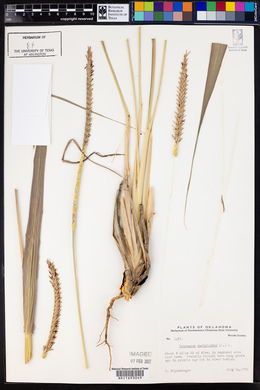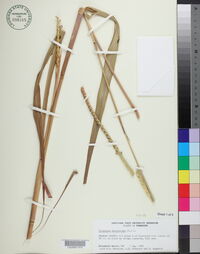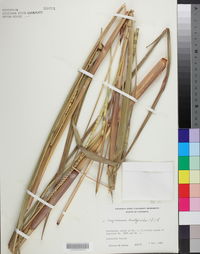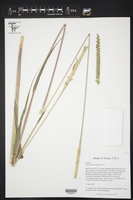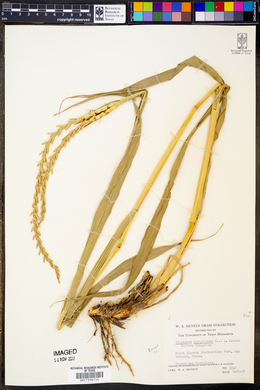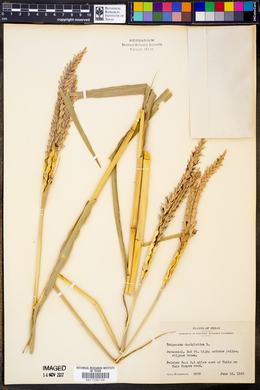

- Home
- Specimen Search
- Images
- Flora Projects
- Agency Floras
- Dynamic Floras
-
Additional Websites
- New Mexico Flores
- Plant Atlas Project of Arizona (PAPAZ)
- Southwest Colorado Wildflowers
- Vascular Plants of the Gila Wilderness
- Consortium of Midwest Herbaria
- Consortium of Southern Rocky Mountain Herbaria
- Intermountain Region Herbaria Network (IRHN)
- Mid-Atlantic Herbaria
- North American Network of Small Herbaria (NANSH)
- Northern Great Plains Herbaria
- Red de Herbarios del Noroeste de México (northern Mexico)
- SERNEC - Southeastern USA
- Texas Oklahoma Regional Consortium of Herbaria (TORCH)
- Resources
|
|
|
|
Family: Poaceae
Eastern Mock Grama, more...Eastern Gamagrass (es: zacate maiz)
[Coix angulata Mill., moreCoix dactyloides L., Ischaemum glabrum Walter, Tripsacum dactyloides f. prolificum R.S. Dayton & Dewald, Tripsacum dactyloides var. angustifolium Scribn., nom. nud., Tripsacum dactyloides var. floridanum , Tripsacum dactyloides var. monostachyon (Willd.) Eaton & J. Wright, Tripsacum dactyloides var. monostachyum (Willd.) Hack., Tripsacum dactyloides var. occidentale H.C.Cutler & E.S.Anderson, Tripsacum monostachyon Willd.] |
Plants with short, knotty rhizomes. Culms 1-2(4) m tall, 3-5 mm thick, clumped. Sheaths usually glabrous, occasionally slightly pilose; ligules ciliate; blades 30-75(120) cm long, 9-35(45) mm wide, flat, usually glabrous, tapering to attenuate apices. Terminal inflorescences erect, with (1)2-3(6) rames; rames 12-25 cm. Pistillate spikelets 6-8 mm long, 3-5.5 mm wide. Staminate spikelets all sessile or subsessile; glumes 5-12 mm, coriaceous, blunt, acute, or bifid; pedicels, when present, about 1 mm long, 0.5-0.8 mm wide, triangular in cross section, rigid. 2n = 36, 54, 72. Tripsacum dactyloides grows in water courses and limestone outcrops from the central and eastern United States through Mexico to northern South America. Plants from the United States and northern Mexico belong to Tripsacum dactyloides (L.) L. var. dactyloides. They differ from those of the other two varieties in their erect stems and sessile staminate spikelets. Narrow-bladed plants of T. dactyloides from Texas resemble T. floridanum, but on transplanting to favorable conditions develop the wider blades characteristic of T. dactyloides. The two species can hybridize; the hybrids are partially sterile. Growing Tripsacum dactyloides for forage has proven practical only in South America. It is also used as an ornamental grass, the chief attraction being its foliage. Perennial herb with short, knotty rhizomes 1 - 4.25 m tall Leaves: with an open, often hairless sheath and membranous ligules lined with hairs along the margins. The blades are 30 cm - 1.2 m long, 0.9 - 4.5 cm wide, flat with a pointed tip, and often hairless. Inflorescence: terminal and axillary, branched (panicle), the terminal inflorescence erect with one to six spikes 12 - 25 cm long. Fruit: a caryopsis. Culm: clumped, 1 - 4 m long, 3 - 5 mm across. Spikelets: either stalkless or stalked, with female spikelets beneath the male spikelets in the same inflorescence. The male spikelets are paired and stalkless or nearly so, and the female spikelets are not paired, 6 - 8 mm long, and 3 - 5.5 mm wide. Glumes: of male spikelets are 5 - 12 mm long, leather-like, blunt, pointed or cleft at the tip. Female spikelets have leather-like lower glumes that cover the florets and upper glumes that are similar but smaller. Florets: having transparent, unawned lemmas and paleas. Lower florets of female spikelets are sterile. Similar species: No information at this time. Flowering: May to September Habitat and ecology: Rare in the Chicago region, growing in railroad ballast. Occurence in the Chicago region: native Etymology: Tripsacum is of unknown origin. Dactyloides means "with fingers." Author: The Morton Arboretum Culms 1-3 m, in large clumps from thick rhizomes; blades elongate, often to 2 cm wide; spikes 1-4, 10-25 cm, the lower fourth or third pistillate; spikelets 7-10 mm; first glume of the pistillate spikelets toward the outside of the pit, indurate, ovate, acute; both staminate spikelets of a pair sessile or subsessile, the outer glumes oblong; 2n=18,
36, 45, 54, 72, 90, 108. Swamps and wet soil; trop. Amer., n. in e. and c. U.S. to Mass., s. Mich. (only casual), Io., and Nebr. Gleason, Henry A. & Cronquist, Arthur J. 1991. Manual of vascular plants of northeastern United States and adjacent Canada. lxxv + 910 pp. ©The New York Botanical Garden. All rights reserved. Used by permission. From Flora of Indiana (1940) by Charles C. Deam I have found this species only twice. A few colonies were in a low, wet woods about three fourths of a mile southeast of the old Spencer School, about 10 miles southwest of Mt. Vernon, Posey County; and it was common along a ditch through a low field about 5 miles east of Lincoln City, Spencer County. I moved two colonies to Bluffton 6 years ago, and they are hardy and spreading. …… Indiana Coefficient of Conservatism: C = 2 Wetland Indicator Status: FAC |
|
|
|

Powered by Symbiota





























